
Animal Dispersal
Chapman and Hall (Verlag)
978-0-412-29330-6 (ISBN)
4.1.1 Demographic significance Confined populations grow more rapidly than populations from which dispersal is permitted (Lidicker, 1975; Krebs, 1979; Tamarin et at., 1984), and demography in island populations where dispersal is restricted differs greatly from nearby mainland populations (Lidicker, 1973; Tamarin, 1977, 1978; Gliwicz, 1980), clearly demonstrating the demographic signi ficance of dispersal. The prevalence of dispersal in rapidly expanding populations is held to be the best evidence for presaturation dispersal. Because dispersal reduces the growth rate of source populations, it is generally believed that emigration is not balanced by immigration, and that mortality of emigrants occurs as a result of movement into a 'sink' of unfavourable habitat. If such dispersal is age- or sex-biased, the demo graphy of the population is markedly affected, as a consequence of differ ences in mortality in the dispersive sex or age class. Habitat heterogeneity consequently underlies this interpretation of dispersal and its demographic consequences, although the spatial variability of environments is rarely assessed in dispersal studies.
One. Introductory chapters.- 1 The study of dispersal: a conceptual guide.- 2 To disperse or not to disperse: who does it and why?.- 3 The genetic consequences of dispersal.- Two. The process of dispersal.- 4. Habitat heterogeneity and dispersal: environmental and genetic patchiness.- 5 Social Factors in immigration and emigration.- Three. Patterns: cyclic versus stable populations.- 6 Patterns of dispersal in non-cyclic populations of small rodents.- 7 The role of dispersal in cyclic rodent populations.- Four. Applications.- 8 Small mammal dispersal in pest management and conservation.- Five. Looking backward and forward.- 9 Presaturation and saturation dispersal 15 years later: some theoretical considerations.- Six. Invited commentaries.- 10 Do large mammals disperse like small mammals?.- 11 The primate perspective on dispersal.- 12 A red grouse perspective on dispersal in small mammals.- 13 An entomological perspective on animal dispersal.- Seven. Appendices.- Appendix 1. Where do we stand methodologically about experimental design and methods of analysis in the study of dispersal?.- A1.1 Introduction.- A1.2 Techniques for obtaining data.- A1.3 Methods of analysis.- A1.4 Future directions.- References.- Appendix 2. Alternative approaches to the study of small mammal dispersal: insights from radiotelemetry.- A2.1 Introduction.- A2.2 Verification of dispersal.- A2.3 Description of movements.- A2.4 The location of dispersers.- A2.5 Dispersal distance.- A2.6 Dispersal frequency.- A2.7 Future studies.- A2.8 Conclusions.- References.- Appendix 3. The use of radioisotopes in the study of dispersal: with a case study.- A3.1 Introduction.- A3.2 A brief survey of radioisotope use in population studies.- A3.3 The Myllymäki-Hansson-Hoff study.- A3.4 Conclusions.- References.-Epilogue.
...it provides an introduction to the problems and potential significance of other animals' dispersal that is missing in other books...any student of dispersal will want this book on hand - BioScience; ...very useful for all researchers that have been studying and are planning to study problems concerning dispersal - Animal Behaviour; ...a detailed organic review of the main problems of animal dispersion. N C Stenseth and W Z Lidicker have done a praiseworthy job both as editors and authors - Ethology, Ecology and Evolution; ...this book especially useful for graduate students and others beginning research on dispersal...concise and well-organized reviews - The Quarterly Review of Biology; The book is obviously the product of a clear objective and careful planning. The mix of perspectives and styles of the two editors and the authors gives this book a dynamic and fascinating character. This collaboration by two individuals with different approaches and perspectives should provide a model for the field of small-mammal ecology. This book embodies a major advance in the study of animal dispersal. It would be outstanding material for a graduate seminar in ecology, ethology, or mammalogy, as it reveals a dynamic field at the apex of its vigor... this book is far more cohesive than typical conference proceedings. It provides fertile ground for graduate students and established researchers searching for new ideas. It is essential reading for small-mammal ecologists and strongly recommended for specialists on other taxa who are interested in dispersal.
| Erscheint lt. Verlag | 31.12.1991 |
|---|---|
| Zusatzinfo | XIII, 365 p. |
| Verlagsort | London |
| Sprache | englisch |
| Maße | 155 x 235 mm |
| Themenwelt | Naturwissenschaften ► Biologie ► Evolution |
| Naturwissenschaften ► Biologie ► Ökologie / Naturschutz | |
| ISBN-10 | 0-412-29330-7 / 0412293307 |
| ISBN-13 | 978-0-412-29330-6 / 9780412293306 |
| Zustand | Neuware |
| Haben Sie eine Frage zum Produkt? |
aus dem Bereich


